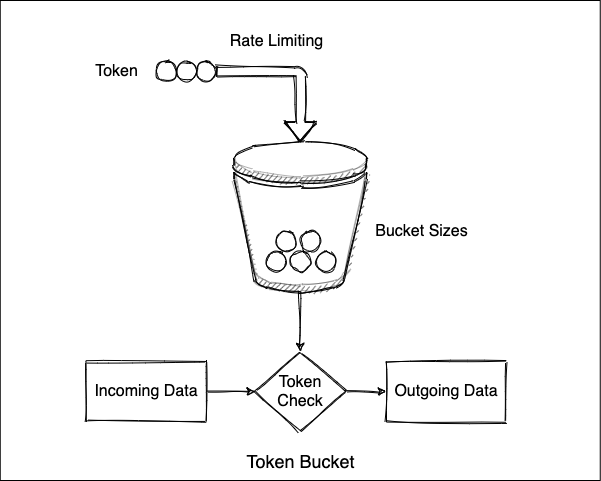[System Design] Token Bucket Algorithm for Rate Limiting: From Single Server to Distributed Systems
Rate limiting is an essential technique for protecting APIs and services from overuse, whether malicious or unintentional. Among the various rate limiting algorithms, the Token Bucket stands out for its simplicity and effectiveness.
Understanding the Token Bucket Algorithm
The Token Bucket algorithm uses a simple metaphor: imagine a bucket that holds tokens. Tokens are added to the bucket at a constant rate (the refill rate), and each incoming request consumes a token. If tokens are available, the request proceeds; otherwise, it's rejected or delayed.
Core Components:
Bucket: A container with a maximum capacity
Tokens: Units that represent permission to process requests
Refill Rate: How quickly new tokens are added (e.g., 4 tokens per second)
Implementation for a Single Server
Here's our Python implementation:
import time
class TokenBucket:
def __init__(self, refill_rate, bucket_capacity):
"""
Initialize the token bucket.
Args:
refill_rate: Number of tokens to add per second
bucket_capacity: Maximum number of tokens the bucket can hold
"""
self.refill_rate = refill_rate
self.bucket_capacity = bucket_capacity
self.current_tokens = bucket_capacity # Start with a full bucket
self.last_refill_time = time.time()
def allow_request(self, tokens_required=1):
"""
Check if a request can be allowed and consume tokens if possible.
Args:
tokens_required: Number of tokens required for this request
Returns:
Boolean indicating if the request is allowed
"""
self.refill()
if self.current_tokens >= tokens_required:
self.current_tokens -= tokens_required
return True
else:
return False
def refill(self):
"""
Refill the bucket based on elapsed time since last refill.
"""
current_time = time.time()
time_elapsed = current_time - self.last_refill_time
# Calculate tokens to add based on elapsed time
tokens_to_add = time_elapsed * self.refill_rate
# Update token count and cap at bucket capacity
self.current_tokens = min(self.bucket_capacity, self.current_tokens + tokens_to_add)
# Update last refill time
self.last_refill_time = current_time
Example: Single Server Scenario
Let's walk through a concrete example with:
Bucket capacity: 10 tokens
Refill rate: 4 tokens per second
Timeline of Events:
t = 0ms:
Initial state: Bucket has 10 tokens
Request arrives
Allow request, consume 1 token
Remaining tokens: 9
t = 300ms:
Time elapsed: 300ms
Tokens added: 4 tokens/sec × 0.3 sec = 1.2 tokens
Tokens before request: 9 + 1.2 = 10.2 tokens (capped at 10)
Request arrives
Allow request, consume 1 token
Remaining tokens: 9
This works perfectly for a single server, but what happens in a distributed environment?
The Distributed Challenge
In modern architectures, applications typically run across multiple servers or containers for scalability and reliability. This presents a challenge for rate limiting.
Problem: Independent Buckets
If each server maintains its own token bucket:
A system with 4 replicas would effectively allow 4 times the intended rate limit
Clients could bypass rate limits by distributing requests across different servers
The overall system would lack consistent enforcement of rate limits
Scenario with 4 Replicas (Independent Buckets)
If each of our 4 servers has its own bucket with capacity 10 and refill rate 4 tokens/sec:
Total system capacity: 40 tokens
Total system refill rate: 16 tokens/sec
This effectively quadruples our rate limit, which is unlikely to be the intended behavior.
Solutions for Distributed Rate Limiting
Centralized Token Storage
The most common solution is to use a centralized data store for token information:
Redis-Based Implementation:
Store token counts in Redis
Use atomic operations for incrementing/decrementing
Leverage Redis's time-to-live features for token refills
import time
import redis
class DistributedTokenBucket:
def __init__(self, redis_client, key_prefix, refill_rate, bucket_capacity):
self.redis = redis_client
self.key_prefix = key_prefix
self.refill_rate = refill_rate
self.bucket_capacity = bucket_capacity
def allow_request(self, identifier, tokens_required=1):
"""Check if a request is allowed for the given identifier"""
bucket_key = f"{self.key_prefix}:{identifier}:bucket"
last_update_key = f"{self.key_prefix}:{identifier}:last_update"
# Use Redis pipeline for atomic operations
pipe = self.redis.pipeline()
# Get current values or set defaults
pipe.get(bucket_key)
pipe.get(last_update_key)
result = pipe.execute()
current_tokens = float(result[0]) if result[0] else self.bucket_capacity
last_update = float(result[1]) if result[1] else time.time()
# Calculate refill
now = time.time()
time_elapsed = now - last_update
tokens_to_add = time_elapsed * self.refill_rate
# Update tokens
new_tokens = min(self.bucket_capacity, current_tokens + tokens_to_add)
# Check if we have enough tokens
if new_tokens < tokens_required:
return False
# Consume tokens atomically
new_tokens -= tokens_required
# Update Redis
pipe = self.redis.pipeline()
pipe.set(bucket_key, new_tokens)
pipe.set(last_update_key, now)
pipe.execute()
return True
Benefits of Centralized Approach
Consistent Enforcement: All servers reference the same token count
Precise Control: Global rate limits are accurately maintained
Flexibility: Can implement different limits for different users/resources
Considerations for Production Use
Performance: Redis operations add latency to each request
Reliability: Need to handle Redis failures gracefully
Scalability: For extremely high volume APIs, consider:
Sharding rate limits by user/resource
Using local caches with periodic synchronization
Implementing backoff strategies
Further reading resources
Conclusion
The Token Bucket algorithm provides an elegant solution for rate limiting, but requires additional consideration in distributed environments. By centralizing token storage with tools like Redis, we can maintain consistent rate limiting across any number of application instances.
Whether you're protecting your APIs from abuse, managing resource consumption, or ensuring fair usage across your user base, properly implemented distributed rate limiting is an essential component of modern system design.





